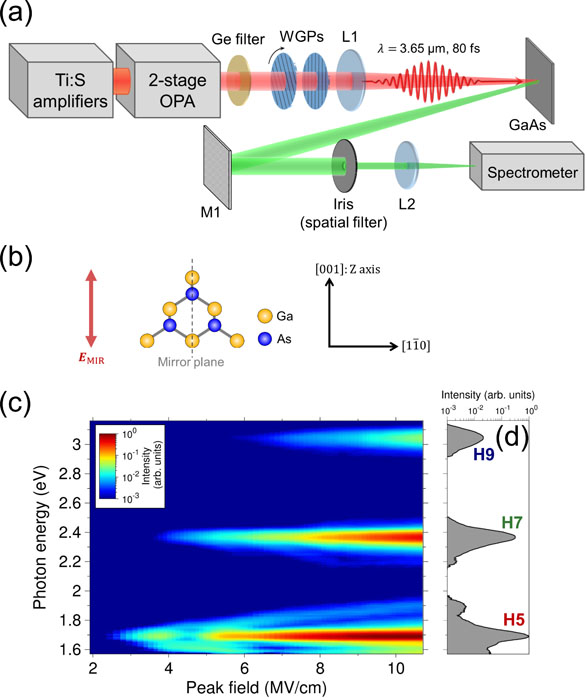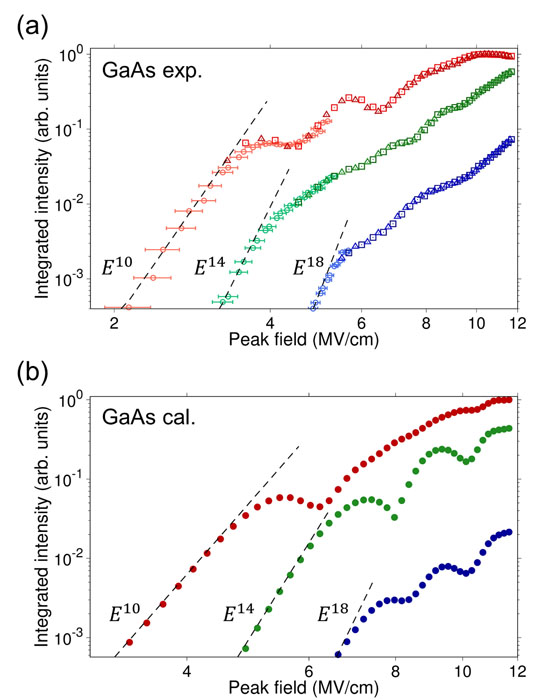High-Harmonic Generation in GaAs beyond the Perturbative Regime
Itatani and Kato Groups
Recently, high-harmonic generation (HHG) has been experimentally observed in solids. In contrast to gaseous media, solids have the vastly diverse nature such as in their band structures, energy gaps, crystalline anisotropy, and magnetism. It has thus far been experimentally and theoretically investigated in various solids, but comprehensive understanding of the crossover behavior from the perturbative to the nonperturbative regime has not been gained yet. Such an understanding requires a unified viewpoint connecting the perturbative to nonperturbative regimes.
In the perturbative regime, it is well known that the intensity of the nth-order harmonics obeys an E2n scaling law with respect to the field amplitude E. In the conventional formulation of nonlinear optics using the Bloch basis, this scaling law is successfully explained by the multiphoton interband transition of Bloch electrons. The E2n scaling, however, breaks down at sufficiently high fields (typically at several MV/cm). In recent theoretical studies, this nonperturbative nature of HHG is explained by the alternative formulation, in which intraband electron acceleration motion is taken into account with a new basis called the Houston basis. In spite of these theoretical developments, it has not been clarified yet how the properties of HHG in the nonperturbative regime are seamlessly connected to those in the perturbative regime where the E2n scaling holds. For a clear understanding on this crossover behavior, accurate measurement of the field-intensity dependences of HHG is crucial and indispensable.
Based on this motivation, we experimentally and theoretically investigated the field-intensity dependence of HHG in GaAs [1]. The experiments were carried out by using an intense mid-infrared laser irradiating a GaAs sample, as shown in Fig. 1(a) , in the reflection geometry to minimize nonlinear propagation effects and phase mismatch [2]. We set the pulse duration and the wavelength of the incident light to be 80 fs and 3.65 μm. The peak field was estimated to be up to 12 MV/cm inside the sample. We measured the HHG intensities as a function of the peak field of the incident pulses from 2 to 12 MV/cm. We show in Figs. 1(c) and 1(d) the obtained HHG spectra which indicate only odd-order harmonics due to the inversion symmetry of GaAs (Fig. 1(b)). Fig. 2(a) shows the intensities of the 5th, 7th, and 9th harmonics as a function of laser intensity. This figure indicates that harmonic intensities did not saturate monotonically with increasing laser intensity, but rather exhibited oscillations. As the field intensity was increased, the oscillatory behaviors appeared above 4, 5, and 6 MV/cm for the 5th, 7th, and 9th harmonics, respectively, where they started to deviate from the perturbative scaling law. An explanation of these experimental results will require clarification of the crossover of HHG from the perturbative to the nonperturbative regime as well as the physical origin of the oscillatory behavior.

Fig. 1. (a) Experimental setup for HHG in reflection geometry using bulk GaAs and MIR laser source. Ti:Sapphire regenerative and multipass amplifiers (450Hz, 5 mJ, 70 fs) were used to pump the optical parametric amplifier (OPA). WGPs, a pair of wire-grid polarizers; L1 (f = 300 mm) and L2 (f = 50 mm), CaF2 lenses; M1 (R = 100 mm), Al-coated concave mirror. (b) Structure of the (110) surface of GaAs and direction of the laser polarization. (c) Field-intensity dependences of the 5th, 7th, and 9th harmonic spectra. (d) HHG spectrum at the peak field of 10 MV/cm.

Fig. 2. (a) Field-intensity dependences of the 5th (red), 7th (green), and 9th (blue) HHG intensities. Two datasets (squares and triangles) were measured in a single sweep starting from 2 to 12 MV/cm and then from 12 to 2 MV/cm, respectively. Small HHG signals (circles) were measured with a longer acquisition time. (b) Calculated results of the Luttinger-Kohn model. In the weak-field regime, the harmonic intensities almost obey an E2n perturbative scaling law for both the measured and calculated results (dashed black lines).
To analyze these experimental results, we employed an eight-band Luttinger-Kohn model, which includes conduction, heavy-hole, light-hole, and split-off bands for both spin-up and spin-down components. We introduce our theoretical framework by applying our previous works [3,4] to the Luttinger-Kohn model and calculate the intensities of the 5th, 7th, and 9th harmonics originating from GaAs. Consequently, we succeed in reproducing E2n scaling laws in the perturbative regime as well as the oscillatory behaviors in the non-perturbative regime (Fig.2(b)). By performing further analyzation, we concluded that the diagonal elements of the Hamiltonian representing field-induced dynamic band modification is crucial in the nonperturbative regime. Since this field-induced dynamic band modification can naturally be ignored in the perturbative regime, we can easily obtain the HHG intensities showing the crossover behavior from the perturbative to the nonperturbative regime. The findings of our work give important foundation for understanding a variation of nonlinear optics from the perturbative to nonperturbative regime and open up the possibility of novel optical technologies, such as strong-field coherent control of solid HHG and Floquet engineering of dressed states in solids.
References
- [1] T. Tamaya, P. Xia, C. Kim, F. Lu, T. Kanai, N. Ishii, J. Itatani, H. Akiyama, and T. Kato, Phys. Rev. B 104, L121202 (2021).
- [2] P. Xia, C. Kim, F. Lu, T. Kanai, H. Akiyama, J. Itatani, and N. Ishii, Opt. Express 26, 29393 (2018).
- [3] T. Tamaya, A. Ishikawa, T. Ogawa, and K. Tanaka, Phys. Rev. Lett. 116, 016601 (2016).
- [4] T. Tamaya and T. Kato, Phys. Rev. B 100, 081203(R) (2019).
